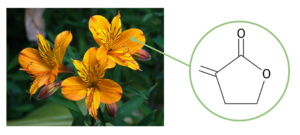I recently stumbled across a post on Reddit where a cat had taken a bite out of a flower bouquet and became sick. In the comments section, the plant was quickly identified as a member of the genus Alstroemeria, which is more commonly known as the Peruvian Lily and is native to South America. Plants in the genera Alstroemeria and Tulipa are toxic to animals due to a compound called tulipalin A that acts as a defense mechanism against predators. I soon learned that not only is tulipalin A harmful towards animals, but it’s also behind a common form of contact dermatitis in humans called “Tulip Fingers”.

The “Tulip Fingers” affliction has long-plagued floral industry workers and home gardeners who regularly handle tulip bulbs without proper skin protection. Tulipalin A was first identified as a causative agent behind Tulip Fingers in a 1969 study. Researchers analyzed tulip bulb extracts using skin patch tests and chemical techniques to conclude that α-methylene γ-butyrolactone (a.k.a. tulipalin A) is responsible for the allergic response. Subsequent studies later identified tuliposide A, the precursor of tulipalin A, as another allergen found in tulip bulbs. These irritating compounds work together to defend their plants and inflict contact dermatitis on unsuspecting predators.
Contact dermatitis is an irritating, sensitized rash caused by direct contact with an allergen, resulting in a T-cell mediated immune response. While contact dermatitis can be caused by a multitude of substances, a 2016 study attempted to uncover the immune response specific to tulipalin A exposure. Researchers found that tulipalin A altered the amounts of dozens of proteins in T cells, including proteins that respond to cell stress, work in DNA replication, and drive cell division. These changes likely promote a T cell population growth to boost the immune response.
Recently, scientists have identified innovative uses for tulipalin A. One 2022 study made derivatives of tulipalin A by carefully modifying its structure in order to harness its inherent protective ability for tulips. The researchers directed that effort towards fighting viruses and fungi that target crops, such as the Valsa mali fungus known to destroy apple trees and the Tobacco Mosaic Virus that impacts over 200 species of crop vegetables and ornamental flowers. Another research group found a way to link together a single tulipalin A molecule (a “monomer”) into a repeating chain of tulipalin A molecules (a “polymer”), with the intention to create a more sustainable plastic with ingredients from biorenewable sources instead of fossil fuels.
Overall, tulipalin A’s history as an irritant towards animals and humans alike could be eclipsed by its potential to benefit us through improved crop yields and greener materials.
Peer editor: Tiffany Peters